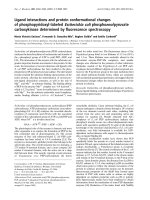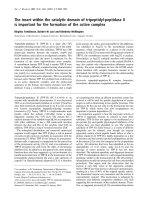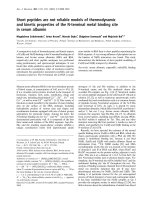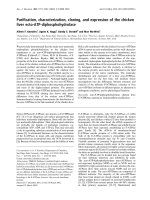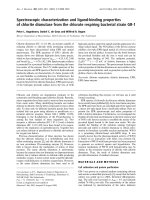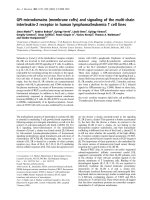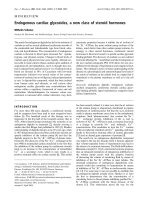Báo cáo y học: "Endoscopic laminoforaminoplasty success rates for treatment of foraminal spinal stenosis: report on sixty-four cases"
Bạn đang xem bản rút gọn của tài liệu. Xem và tải ngay bản đầy đủ của tài liệu tại đây (204.16 KB, 4 trang )
Int. J. Med. Sci. 2009, 6
102
I
I
n
n
t
t
e
e
r
r
n
n
a
a
t
t
i
i
o
o
n
n
a
a
l
l
J
J
o
o
u
u
r
r
n
n
a
a
l
l
o
o
f
f
M
M
e
e
d
d
i
i
c
c
a
a
l
l
S
S
c
c
i
i
e
e
n
n
c
c
e
e
s
s
2009; 6(2):102-105
© Ivyspring International Publisher. All rights reserved
Research Paper
Endoscopic laminoforaminoplasty success rates for treatment of foraminal
spinal stenosis: report on sixty-four cases
Scott M.W. Haufe
1,3
, Anthony R. Mork
2,3
, Morgan A. Pyne
3
, and Ryan A. Baker
3
1. Chief of Pain Medicine and Anesthesiology
2. Chief of Spine Surgery
3. MicroSpine, DeFuniak Springs, FL 32435, USA
Correspondence to: Scott M.W. Haufe, M.D., 101 MicroSpine Way, DeFuniak Springs, FL 32435. Phone: 888-642-7677; Fax:
850-892-4212; Email:
Received: 2009.02.09; Accepted: 2009.03.19; Published: 2009.03.22
Abstract
Background: Foraminal stenosis is an important cause of radicular and generalized back pain.
In patients who do not respond to conservative interventions, endoscopic spinal surgery
provides similar results to open surgical approaches with lower rates of complication,
postoperative pain, and shorter duration of hospital stay.
Methods: We performed a prospective, open, uncontrolled trial of 64 patients to evaluate
endoscopic laminoforaminoplasty for the treatment of refractory foraminal stenosis.
Results: Fifty-nine percent of patients had at least 75% improvement in Oswestry Disability
Index (Oswestry) and Visual Analog Scale (VAS) scores. All patients were discharged the day
of surgery. Dural leaks occurred in two patients, which were repaired intraoperatively. No
other adverse events occurred.
Conclusions: Endoscopic laminoforaminoplasty appears to be a safe alternative to open de-
compression in patients with spinal foraminal stenosis; additional controlled trials are war-
ranted.
Key words: endoscopic laminoforaminoplasty, spinal foraminal stenosis, minimally invasive
surgery
Introduction
Foraminal stenosis is an important cause of
radicular and generalized back pain. Lateral root en-
trapment has an incidence of 8 to 11%[1] [2][3]. A lack
of signs, symptoms, and radiographic findings spe-
cific to foraminal stenosis may lead to failed treatment
[4] [5], and may be the cause of pain in up to 60% of
patients who remain symptomatic postoperatively [4].
Initial treatment for symptomatic foraminal
stenosis is centered on aggressive conservative
methods, including mobilization, activity modifica-
tion, anti-inflammatory medications, steroid injec-
tions, and selective nerve root block. Patients refrac-
tory to conservative management are candidates for
surgical decompression.
While anterior or posterior open surgical ap-
proaches are associated with good outcome, a sig-
nificant number of patients have postsurgical symp-
toms, including pain, weakness, and changes in sen-
sorium. In addition, open surgical techniques are as-
sociated with significant risks. An anterior surgical
approach places the patient at risk of damage to im-
portant neurovascular structures, and both anterior
and posterior approaches are associated with an in-
creased risk of infection and neurological damage.
Int. J. Med. Sci. 2009, 6
103
Endoscopic surgical techniques have been ap-
plied to vertebral surgery with good outcome. These
methods are associated with a lower risk of infection
and major neurovascular or organ damage, increased
rate of recovery, and shorter duration of hospital stay.
In this paper we present the results of an open, non-
randomized trial of endoscopic laminoforaminoplasty
for the treatment of foraminal spinal stenosis.
Methods
This was a prospective study of 64 patients who
underwent endoscopic laminoforaminoplasty for re-
fractory foraminal stenosis. Inclusion criteria were
foraminal stenosis documented by magnetic reso-
nance imaging (MRI) or computerized tomography
(CT) and symptoms noted on physical exam. Patients
with stenosis due to either intervertebral disc or
boney compression were included, and were treated
with an identical operative procedure to decompress
the foraminal canal. Prior to surgery, radicular pain
was confirmed with either nerve conduction studies
and/or nerve blocks. Exclusion criterion was prior
spinal surgery. There was no sham or control group.
Patients were followed by phone or personal inter-
view for greater than 24 months postoperatively. All
surgeries were performed under intravenous (IV)
sedation with the patient able to communicate in or-
der to reduce neurological injury. All the surgeries
were performed on an outpatient basis, and all pa-
tients signed informed consent documents prior to
surgery.
The surgery commenced as follows: Intravenous
(IV) antibiotics were administered perioperatively;
cefazolin was used unless there was an allergy, in
which case ciprofloxacin was substituted. The proce-
dure is performed under Monitored Anesthesia Care
sedation, in which the patient is sedated with benzo-
diazepines and opioids but is conscious to aid in the
protection of the nerves during the procedure. The
entry site is determined via fluoroscopy. A scalpel is
used to make a stab wound through which a
guide-wire is inserted down to the facet region of the
vertebral body associated with stenosis. Over this
guide-wire, a commercially available dilating system
is used to dilate the tissues to approximately 14mm.
First, a 14mm tube is inserted and the inner pieces are
removed; this is considered the working tube. A
12mm drill bit is used to create a window into the
foraminal canal. This is done utilizing fluoroscopy to
determine the depth of penetration of the drill unit.
Electrocautery and holmium lasers are used for
hemocoagulation and soft tissue removal. Once the
bone and newly drilled hole is visualized, a standard
mechanical burr system is utilized to grind away the
lamina of the vertebral body and to widen the open-
ing that was created with the 12mm bit. Kerrisons and
pituitaries are utilized during the entire process to
smooth the edges of the bone that had been burred
and for general debulking of soft issues and loose
bone fragments. Holmium laser was also used to de-
compress the disc. During the entire process a general
zero degree with 30X magnification is used for visu-
alization. Once the region of the lamina and foraminal
canal is properly opened, the procedure is completed
and the dilation tube is removed.
Outcome measures were percent change from
baseline in Oswestry Disability Index (Oswestry) and
Visual Analog Scale (VAS) scores.
Results
Sixty-four patients were enrolled, including 37
males and 27 females. The age range was 32 to 90
years of age with the median age of 62. All patients
had radicular symptoms greater than 3 months and
failed conservative treatments. All patients under-
went epidural steroid injections and physical therapy
before being considered for surgery.
Total time for the surgery was between 30 min-
utes and 1.5 hours with the mean of 50 minutes actual
surgical time. Most patients were discharged within 1
hour of reaching the PACU (range 42 to 121 minutes)
and all patients were discharged the same day. The
only complication was dural leak, which occurred in
two patients and was corrected intraoperatively with
Duragen. No infection or neurovascular injury oc-
curred.
Percent change in Oswestry and VAS are pre-
sented in Table 1. Mean follow up time was 38 months
(range: 24-45 months). Over half (59%) of patients
showed 75-100% improvement in Oswestry score, and
59% showed 75 to 100% improvement in VAS score.
Table 1. Percent improvement in Visual Analog Scale
(VAS) pain score and Oswestry Disability Score following
endoscopic laminoforaminoplasty.
Percent im-
provement
Number of patients
showing change in
VAS
Number of patients
showing change in
Oswestry
75-100% 42 38
50-74% 4 9
25-49% 5 3
1-24% 3 4
0 (no change) 6 3
-1-24% (worse) 2 4
-25-49% (worse) 2 2
-50-74% (worse) 0 1
Int. J. Med. Sci. 2009, 6
104
Discussion
Foraminal stenosis is an important cause of spi-
nal nerve root compression that is amenable to both
conservative and surgical treatments. Open surgical
decompression may be carried out via a midline ap-
proach, which may be performed as interlaminar ex-
posure, laminotomy, laminectomy, medial facetec-
tomy, medial foraminotomy, or muscle-splitting
Wiltse or lateral approach with foraminotomy [6] [7]
[8] [9]. Cases requiring complete foraminal decom-
pression may be treated with a combined interlaminar
and lateral approach [6]. In a report of 65 surgical
cases of lumbar foraminal stenosis, laminectomy and
foraminotomy was the most common treatment (52
patients), followed by laminotomy and foraminotomy
(23 patients) [10]. Results were excellent or good in 29
(45%) and 25 (39%) patients, respectively, at
32.5-month follow-up. These results are consistent
with other small studies, with good results reported in
the majority of cases [11] [12] [13] [14].
Open surgical correction is the current standard
of care, but is not without risks. Blood loss, infection,
prolonged hospital stay, and postoperative pain may
occur regardless of surgical approach. Posterior cer-
vical decompression requires subperiosteal stripping
of the paraspinal muscles, which can result in post-
operative pain, muscular spasms, and loss of function
[15]. Anterior approaches are also frequently used,
but carry significant risk of esophageal or neurovas-
cular injury and damage to tissues along the plane of
section, including major organs [16].
Alternative surgical techniques, such as endo-
scopic approaches, allow for shorter operating time,
reduction in tissue exposure and manipulation, and
decreased risk of damage to surrounding structures.
Fessler et al. [15] reported decreases in fluid loss,
length of hospital stay, and postoperative pain medi-
cation with minimally invasive techniques compared
to open surgery.
Cervical microendoscopic forami-
notomy/discectomy (CMEF/D) provides clinical re-
sults equivalent to those seen with traditional surgical
approaches while reducing blood loss, hospital stay,
and postoperative pain [15] [17]. Similar techniques
for posterior decompression are reported to have
similar outcomes [18] [16] [19] [20], with symptomatic
improvements equal to those found with traditional
surgical techniques.
Our findings of improved pain and disability
scores in the majority of patients agree with other
published trials evaluating endoscopic approaches for
foraminal stenosis, which report positive results in
44-97% [21] [15] [17]. All patients in our study were
discharged the same day and there were no major
complications. Minor dural leaks occurred in two pa-
tients, both of which were corrected intraoperatively.
Our findings are limited by the lack of a control
group, preventing an adequate comparison of endo-
scopic laminoforaminoplasty to conventional open
decompression. However, our results support the
safety of endoscopic interventions and highlight the
need for large scale comparative trials to further de-
termine the relative efficacy of open versus endo-
scopic interventions. Results appear to be similar as
conventional surgery with the possibility of fewer
complications.
Conclusions
Based on data from the current study and pre-
viously published reports, the novel technique of en-
doscopic surgical treatment for foraminal stenosis is
validated as a potentially effective alternative to open
decompression. No adverse events occurred in our
patient population, and pain and disability were im-
proved to the same degree reported in the literature
for open surgical approaches. Additional controlled
trials are warranted to quantify the efficacy and safety
of endoscopic laminoforaminoplasty relative to con-
ventional techniques.
Competing Interest
The authors declare that they have no competing
interests.
References
1. Kunogi J, Hasue M: Diagnosis and operative treatment of intra-
foraminal and extraforaminal nerve root compression. Spine
1991, 16:1312-1320.
2. Porter RW, Hibbert C, Evans C: The natural history of root en-
trapment syndrome. Spine 1984, 9:418-421.
3. Vanderlinden RG: Subarticular entrapment of the dorsal root
ganglion as a cause of sciatic pain. Spine 1984, 9:19-22.
4. Burton CV, Kirkaldy-Willis WH, Yong-Hing K, Heithoff KB: Causes
of failure of surgery on the lumbar spine. Clin Orthop Relat Res
1981, :191-199.
5. Macnab I: Negative disc exploration. An analysis of the causes of
nerve-root involvement in sixty-eight patients. J Bone Joint Surg
Am 1971, 53:891-903.
6. Jenis LG, An HS: Spine update. Lumbar foraminal stenosis.
Spine 2000, 25:389-394.
7. Jackson RP, Glah JJ: Foraminal and extraforaminal lumbar disc
herniation: diagnosis and treatment. Spine 1987, 12:577-585.
8. Lejeune JP, Hladky JP, Cotten A, Vinchon M, Christiaens JL: Fo-
raminal lumbar disc herniation. Experience with 83 patients.
Spine 1994, 19:1905-1908.
9. Wiltse LL: The paraspinal sacrospinalis-splitting approach to
the lumbar spine. Clin Orthop Relat Res 1973, :48-57.
10. Jenis LG, An HS, Gordin R: Foraminal stenosis of the lumbar
spine: a review of 65 surgical cases. Am J Orthop 2001,
30:205-211.
Int. J. Med. Sci. 2009, 6
105
11. Baba H, Uchida K, Maezawa Y, Furusawa N, Okumura Y, Imura S:
Microsurgical nerve root canal widening without fusion for
lumbosacral intervertebral foraminal stenosis: technical notes
and early results. Spinal Cord 1996, 34:644-650.
12. Hejazi N, Witzmann A, Hergan K, Hassler W: Combined transar-
ticular lateral and medial approach with partial facetectomy for
lumbar foraminal stenosis. Technical note. J Neurosurg 2002,
96:118-121.
13. Saringer W, Nöbauer I, Reddy M, Tschabitscher M, Horaczek A:
Microsurgical anterior cervical foraminotomy (uncoforami-
notomy) for unilateral radiculopathy: clinical results of a new
technique. Acta Neurochir (Wien) 2002, 144:685-694.
14. Johnson JP, Filler AG, McBride DQ, Batzdorf U: Anterior cervical
foraminotomy for unilateral radicular disease. Spine 2000,
25:905-909.
15. Fessler RG, Khoo LT: Minimally invasive cervical microendo-
scopic foraminotomy: an initial clinical experience. Neurosur-
gery 2002, 51:S37-S45.
16. Gala VC, O'Toole JE, Voyadzis JM, Fessler RG: Posterior minimally
invasive approaches for the cervical spine. Orthop Clin North
Am 2007, 38:339-49.
17. Adamson TE: Microendoscopic posterior cervical lamino-
foraminotomy for unilateral radiculopathy: results of a new
technique in 100 cases. J Neurosurg 2001, 95:51-57.
18. Khoo LT, Fessler RG: Microendoscopic decompressive lami-
notomy for the treatment of lumbar stenosis. Neurosurgery
2002, 51:S146-S154.
19. Perez-Cruet MJ, Kim BS, Sandhu F, Samartzis D, Fessler RG: Tho-
racic microendoscopic discectomy. J Neurosurg Spine 2004,
1:58-63.
20. Yabuki S, Kikuchi S: Endoscopic partial laminectomy for cervical
myelopathy. J Neurosurg Spine 2005, 2:170-174.
21. Ahn Y, Lee SH, Park WM, Lee HY: Posterolateral percutaneous
endoscopic lumbar foraminotomy for L5-S1 foraminal or lateral
exit zone stenosis. Technical note. J Neurosurg 2003, 99:320-323.

